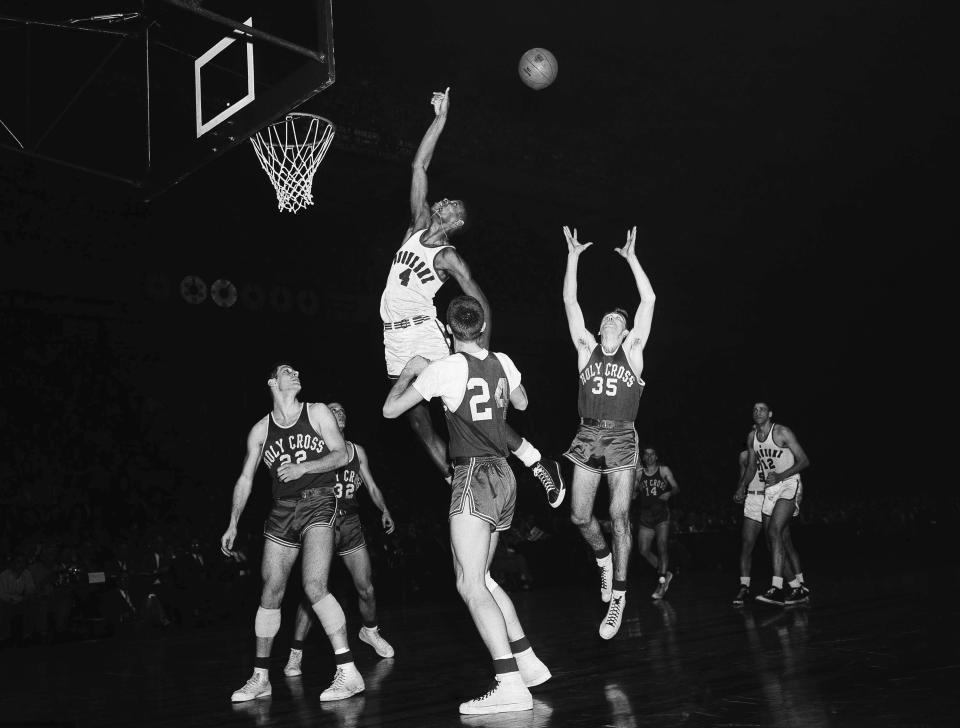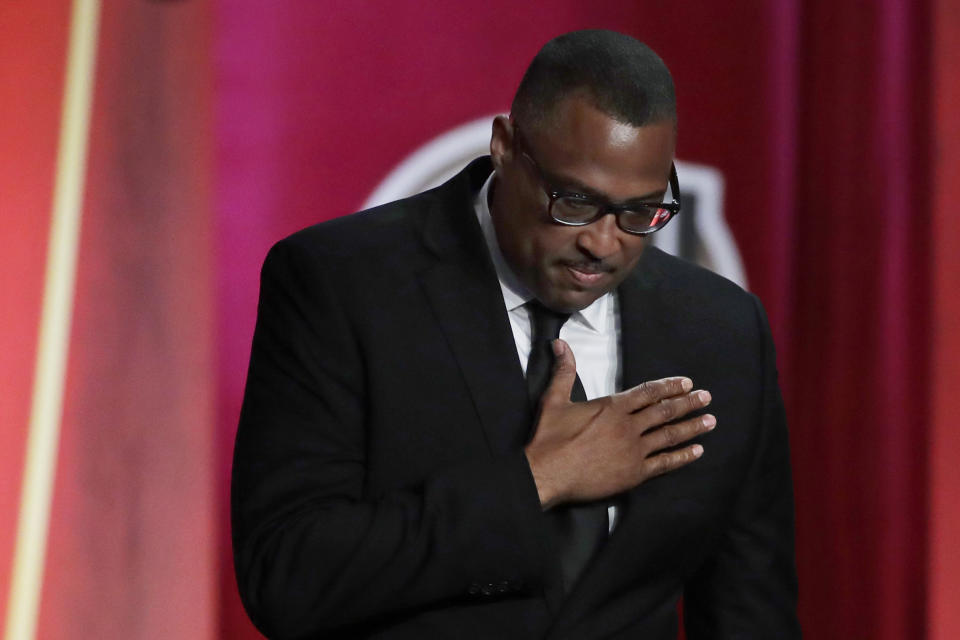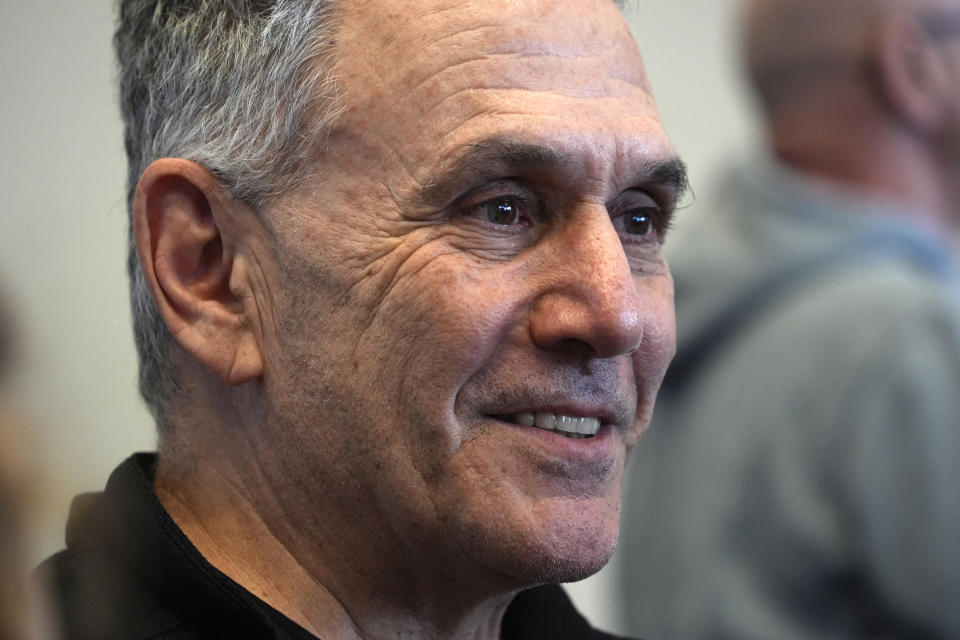March Madness: Long before Duquesne spent 47 years in anonymity, a progressive approach led to glory
PITTSBURGH (AP) — Before Duquesne slid into basketball anonymity and nearly five decades of what coach Keith Dambrot only semi-jokingly describes as “anguish,” there was glory.
Lots of it.
Dambrot heard the tales firsthand from his father Sid, a guard and set-shot wizard on the Dukes' teams of the early 1950s that were fixtures in the AP's top 10 and made deep run after deep run in the National Invitation Tournament, which carried more weight nationally than the NCAA championship at the time.
Duquesne reached those giddy heights while playing with a roster symbolizing the smallish Catholic university's approach to racial and religious diversity.
The 1954 Dukes who walked onto the floor at a sold-out Madison Square Garden to face Holy Cross in the NIT finals featured an all-Black frontcourt in Dick Ricketts, Fletcher Johnson and Sihugo Green and a backcourt shared by Sid Dambrot and Mickey Winograd.
“Three African-Americans and two Jews in a Catholic institution,” Keith Dambrot said. “You know, my dad was always proud of that. And so I think that’s why I came, because I knew the history.”
A history that stretches far beyond the 47 years the Dukes spent in college hoops purgatory, a run that ended on Sunday when Dambrot and Duquesne held off VCU in the Atlantic 10 final to earn the program's first NCAA Tournament berth since 1977. The 11th-seeded Dukes (24-11) will face sixth-seeded BYU (23-10) in Omaha, Nebraska, in the first round on Thursday.
It's a destination Dambrot promised his father's alma mater the program would reach when he arrived in 2017 after a highly successful 14-year run at Akron. The last seven seasons have been rocky at times, from two years serving as nomads while the outdated Palumbo Center morphed into the glistening UPMC Cooper Fieldhouse to a 6-24 slog in 2021-22 that left Dambrot on the verge of quitting.
Yet he persevered, bolstered by an administration committed to restoring the Dukes to relevance and a roster dotted with players from eight countries spread over three continents. Fitting for a school that has long opened its doors to recruits from places others weren't looking, even if the recruits were sometimes hiding in plain sight.
Recruits like Chuck Cooper.
The 6-foot-5 forward starred at Westinghouse High School in Pittsburgh's Homewood neighborhood in the 1940s before joining good friend Bill Nunn — a future scout for the Pittsburgh Steelers and a member of the Pro Football Hall of Fame — for a semester at West Virginia State College, a historically Black school.
A stint in the Navy near the end of World War II beckoned. Cooper was weighing his options when he returned home. Duquesne coach Chick Davies invited Cooper to a practice.
It took all of two hours for Davies to see enough.
“Chick wouldn't let him out of the gym,” Chuck Cooper III said of his father with a laugh.
Davies offered Cooper a chance to become the first acknowledged Black player in program history. (Cumberland Posey, a member of the Baseball and Basketball Halls of Fame, passed for white while playing at Duquesne in the late 1910s under the name Charles Cumbert).
During his time with the Dukes in the late 1940s, the powerful, athletic Cooper became the driving force for a program on the rise, though that rise was sometimes met with resistance.
Cooper was a freshman in December 1946 when the Dukes were scheduled to play Tennessee in McKeesport, a short trip up the Monongahela River from the Duquesne campus. Seeing Cooper on the floor, Volunteers coach John Mauer said Tennessee and its all-white roster would not take the court if Cooper were in the game.
Negotiations went nowhere. Judge Sam Weiss, chairman of the Duquesne University Athletic Council, stepped in.
“The principle of the entire matter means more to us than a mere basketball game,” Weiss said.
The Volunteers forfeited and headed back home to Knoxville. Weiss' decision to ally with Cooper sent a message to Black players across the country that the program was committed to something far greater than the outcome of a game.
“Most often when you make the right decision for the right reasons, good things happen,” Cooper III said. “You have to give them credit for having an open mind and not having race as a barrier.”
The Dukes went 77-19 during Cooper’s career before he graduated in 1950 and became the first Black player to be drafted in the NBA when the Boston Celtics selected him with the first pick of the second round. He played six seasons for four teams and was inducted into the Basketball Hall of Fame in 2019.
It wasn't just Cooper's presence that resonated, but the respect showed to him by Davies and successor Dudey Moore. Rather than limit Cooper to dirty work like rebounding and setting picks, they let him flourish on offense and made him a team captain.
“That really opened the gate to win championships, knowing Duquesne was not only a safe place to come and play, but star and lead,” Cooper III said.
Jim Tucker left Jacksonville, Florida, for a campus tucked atop a bluff overlooking Pittsburgh's downtown in 1952 and later became one of the first Black players to appear in an NBA finals. Dave and Dick Ricketts traveled across the state from their home in Pottstown rather than search for an opportunity closer to Philadelphia.
Green grew up in Brooklyn but hopped the train for Duquesne in search of a better opportunity in a city that at the time had a thriving Black culture in the Hill District just off the Duquesne campus.
“Duquesne was crucial in the integration of college basketball,” said Bob Healy, the director of the school’s Sports Information and Media program and author of multiple books on the Dukes' men's team. “Top Black players propelled Duquesne to the height of college basketball."
In March 1955, a year after Sid Dambrot and company were a runner-up in the NIT, Green, the Ricketts brothers, and Duquesne returned to the Garden and beat Dayton in the finals to win a title at a time when the NCAA's March Madness hadn't taken hold of the public consciousness.
The success didn't last, as more schools followed Duquesne's example and began integrating their rosters, including crosstown rival Pitt. The Panthers, who did not scrimmage or play the Dukes during Cooper's career while the annual “City Game” between the two schools situated just 2 miles apart was on pause, recruited their first Black player in 1954 when Julius Pegues joined the team.
The Dukes remained competitive for most of the next three decades, including qualifying for the NCAA Tournament in 1977 behind the play of future NBA star Norm Nixon. It was the school's last appearance in the Big Dance until this week when the coach whose father regaled him with tales of Duquesne's golden age will lead the Dukes back onto the national stage once again.
It will serve as a full-circle moment for Keith Dambrot, who is retiring after the tournament. It is also a welcome chance for the Dukes to highlight not only what is, but what once was.
“People have forgotten,” Cooper III said. “I think Duquesne punching the tick to the big dance this year is really shining a light on the fact this is a very proud program with a great tradition.”
___
AP March Madness bracket: https://apnews.com/hub/ncaa-mens-bracket and coverage: https://apnews.com/hub/march-madness


